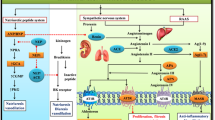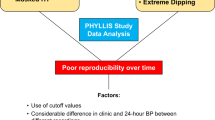Abstract
Endothelial function in elderly hypertensive patients with arteriosclerosis obliterans has not been evaluated. We examined whether antihypertensive drugs improve vasodilatory response to reactive hyperemia of the limbs in elderly hypertensive patients (83±8 [SD] years) without (n=46, 0.9 ≤ ankle-brachial pressure index ≤1.4) and with (n=24) arteriosclerosis obliterans (ankle-brachial pressure index <0.2). Patients were randomized for treatment with monotherapy of either temocapril (14 with and 26 without arteriosclerosis obliterans) or amlodipine (10 with and 20 without arteriosclerosis obliterans) for 6 months. Blood flows of the forearms and legs were measured by strain-gauge plethysmography. The vasodilatory response to the release of compression of the forearms and thighs at 200 mmHg or 20 mmHg more than systolic blood pressure for 5 min and to sublingual administration of nitroglycerin (0.3 mg) was assessed. The maximum reactive hyperemic flow in 35 legs with arteriosclerosis obliterans was significantly (p<0.001) decreased compared to the value in legs in the control hypertensive subjects. Moreover, maximum reactive hyperemic flow in the forearms of patients with arteriosclerosis obliterans was significantly (p=0.002) decreased compared to that in the control subjects. Blood pressure was similarly decreased by treatment with temocapril or amlodipine. Response to nitroglycerin (0.3 mg) was not changed by either drug. Treatment with temocapril significantly improved maximum reactive hyperemic flow of not only the legs and forearms in control hypertensives but also the legs and forearms in patients with arteriosclerosis obliterans, and attenuated the worsening of activity of daily living in these patients, although treatment with amlodipine did not. These results suggest that the angiotensin-converting enzyme inhibitor temocapril has a beneficial effect on endothelial function in elderly patients with arteriosclerosis obliterans.
Similar content being viewed by others
Article PDF
References
Makino H, Aoki M, Hashiya N, et al: Increase in peripheral blood flow by intravenous administration of prostaglandin E1 in patients with peripheral arterial disease, accompanied by up-regulation of hepatocyte growth factor. Hypertens Res 2004; 27: 85–91.
Lambert GE : Management alternatives of infrainguinal arteriosclerosis obliterans in the elderly. Surg Clin North Am 1986; 66: 293–303.
Dormandy J, Mahir M, Ascady G, et al: Fate of the patient with chronic leg ischaemia: a review article. J Cardiovasc Surg (Torino) 1989; 30: 50–57.
Rutherford RB, Flanigan DP, Gupta SK, et al, Ad Hoc Committee on Reporting Standards, Society for Vascular Surgery/North American Chapter, International Society for Cardiovascular Surgery : Suggested standards for reports dealing with lower extremity ischemia. J Vasc Surg 1986; 4: 80–94.
No Authors Listed : Second European Consensus Document on Chronic Critical Leg Ischemia. Circulation 1991; 84 ( 4 Suppl): IV1–IV26.
Hozawa A, Ohmori K, Kuriyama S, et al: C-reactive protein and peripheral artery disease among Japanese elderly: the Tsurugaya Project. Hypertens Res 2004; 27: 955–961.
Olin JW : Antihypertensive treatment in patients with peripheral vascular disease. Cleve Clin J Med 1994; 61: 337–344.
Qian SX, Iwai T, Endo M, Sato S, Muraoka Y, Inoue Y : Comparison of arteriosclerosis obliterans of lower limbs between China and Japan. Bull Tokyo Med Dent Univ 1990; 37: 19–26.
National High Blood Pressure Education Program Working Group: National High Blood Pressure Education Program Working Group report on hypertension in the elderly. Hypertension 1994; 23: 275–285.
Uchida Y, Nakamura F, Morita T : Observation of atherosclerotic lesions by an intravascular microscope in patients with arteriosclerosis obliterans. Am Heart J 1995; 130: 1114–1119.
Milio G, Cospite V, Cospite M : Hypertension and peripheral arterial disease: a plethysmographic study. Angiology 1997; 48: 241–245.
Roberts DH, Tsao Y, McLoughlin GA, Breckenridge A : Placebo-controlled comparison of captopril, atenolol, labetalol, and pindolol in hypertension complicated by intermittent claudication. Lancet 1987; 2: 650–653.
Bernardi D, Bartoli P, Ferreri A, Geri AB, Ieri A : Assessment of captopril and nicardipine effects on chronic occlusive arterial disease of the lower extremity using Doppler ultrasound. Angiology 1988; 39: 942–952.
Lewis P, Psaila JV, Davies WT, Morgan RH, Woodcock JP : Nifedipine in patients with peripheral vascular disease. Eur J Vasc Surg 1989; 3: 159–164.
Iwatsubo H, Nagano M, Sakai T, et al: Converting enzyme inhibitor improves forearm reactive hyperemia in essential hypertension. Hypertension 1997; 29: 286–290.
Deng YB, Wang XF, Le GR, Zhang QP, Li CL, Zhang YG : Evaluation of endothelial function in hypertensive elderly patients by high-resolution ultrasonography. Clin Cardiol 1999; 22: 705–710.
Kuroda K, Tatara K, Takatorige T, et al: Factors related to long-term stay in hospital by elderly people in a Japanese city. Age Aging 1992; 21: 321–327.
Resnick HE, Lindsay RS, McDermott MM, et al: Relationship of high and low ankle brachial index to all-cause and cardiovascular disease mortality: the Strong Heart Study. Circulation 2004; 109: 733–739.
Hokanson DE, Summer DS, Strandness DEJ : An electrically calibrated plethysmograph for direct measurement of limb blood flow. IEEE Trans Biomed Eng 1975; 22: 25–29.
Wassmann S, Hilgers S, Laufs U, Bohm M, Nickenig G : Angiotensin II type 1 receptor antagonism improves hypercholesterolemia-associated endothelial dysfunction. Arterioscler Thromb Vasc Biol 2002; 22: 1208–1212.
Komai N, Ohishi M, Moriguchi A, et al: Low-dose doxazosin improved aortic stiffness and endothelial dysfunction as measured by noninvasive evaluation. Hypertens Res 2002; 25: 5–10.
Fujiwara T, Saitoh S, Takagi S, et al: Prevalence of asymptomatic arteriosclerosis obliterans and its relationship with risk factors in inhabitants of rural communities in Japan: Tanno-Sobetsu study. Atherosclerosis 2004; 177: 83–88.
Elsman BH, Legemate DA, van der Heyden FW, de Vos H, Mali WP, Eikelboom BC : The use of color-coded duplex scanning in the selection of patients with lower extremity arterial disease for percutaneous transluminal angioplasty: a prospective study. Cardiovasc Intervent Radiol 1996; 19: 313–316.
Tagawa T, Imaizumi T, Endo T, Shiramoto M, Harasawa Y, Takeshita A : Role of nitric oxide in reactive hyperemia in human forearm vessels. Circulation 1994; 90: 2285–2290.
Kilbom A, Wennmalem A : Endogenous prostaglandins as local regulators of blood flow in man; effect of indomethacin on reactive and functional hyperemia. J Physiol 1976; 257: 109–121.
Carlsson I, Sollevi A, Wennmalm A : The role of myogenic relaxation, adenosine and prostaglandins in human forearm reactive hyperemia. J Physiol 1987; 389: 147–161.
Panza JA, Quyyumi AA, Brush JE Jr, Epstein SE : Abnormal endothelium-dependent vascular relaxation in patients with essential hypertension. N Engl J Med 1990; 323: 22–27.
Linder L, Kiowski W, Buhler FR, Luscher TF : Indirect evidence for the release of endothelium-derived relaxing factor in human forearm circulation in vivo: blunted response in essential hypertension. Circulation 1990; 81: 1762–1767.
Iiyama K, Nagano M, Yo Y, et al: Impaired endothelial function with essential hypertension assessed by ultrasonography. Am Heart J 1996; 132: 779–782.
Celermajer DS, Sorensen KE, Spiegelhalter DJ, Georgakopoulos D, Robinson J, Deanfield JE : Aging is associated with endothelial dysfunction in healthy men years before the age-related decline in women. J Am Coll Cardiol 1994; 24: 471–476.
Makita S, Nakamura M, Murakami H, Komoda K, Kawazoe K, Hiramori K : Impaired endothelium-dependent vasorelaxation in peripheral vasculature of patients with thromboangiitis obliterans (Buerger's disease). Circulation 1996; 94: 11211–11215.
Zhou JL, Froomes P, Casley D, et al: Perindopril chronically inhibits angiotensin-converting enzyme in both the endothelium and adventitia of the internal mammary artery in patients with ischemic heart disease. Circulation 1997; 96: 174–182.
Hahn AW, Resink TJ, Scott-Burden T, Powell J, Dohi Y, Buhler FR : Stimulation of endothelin mRNA and secretion in the rat vascular smooth muscle cells: a novel autocrine function. Cell Regul 1990; 1: 649–659.
Lin L, Mistry M, Stier CT Jr, Nasjletti A : Role of prostanoids in renin-dependent and renin-independent hypertension. Hypertension 1991; 17: 517–525.
Griendling K, Ollerenshaw JD, Minieri CA, Alexander RW : Angiotensin II stimulates NADH and NADPH activity in cultured vascular smooth muscle cells. Circ Res 1994; 74: 1141–1148.
Kitakaze M, Node K, Takashima S, Minamino T, Kuzuya T, Hori M : Cellular mechanisms of cardioprotection afforded by inhibitors of angiotensin converting enzyme in ischemic hearts: role of bradykinin and nitric oxide. Hypertens Res 2000; 23: 253–259.
Mombouli JV, Illiano S, Nagao T, Scott-Burden T, Vanhoutte PM : Potentiation of endothelium-dependent relaxations to bradykinin by angiotensin I converting enzyme inhibitors in canine coronary artery involves both endothelium-derived relaxing and hyperpolarizing factors. Circ Res 1992; 71: 137–144.
Hornig B, Kohler C, Drexler H : Role of bradykinin in mediating vascular effects of angiotensin-converting enzyme inhibitors in humans. Circulation 1997; 95: 1115–1118.
Tarutani Y, Matsumoto T, Takashima H, Yamane T, Horie M : Brachial artery flow-mediated vasodilation is correlated with coronary vasomotor and fibrinolytic responses induced by bradykinin. Hypertens Res 2005; 28: 59–66.
Zhang X, Hintze TH : Amlodipine releases nitric oxide from canine coronary microvessels: an unexpected mechanism of action of a calcium channel–blocking agent. Circulation 1998; 97: 576–580.
Yang J, Fukuo K, Morimoto S, Niinobu T, Suhara T, Ogihara T : Pranidipine enhances the action of nitric oxide released from endothelial cells. Hypertension 2000; 35: 82–85.
Higashi Y, Oshima T, Sasaki S, et al: Angiotensin-converting enzyme inhibition, but not calcium antagonism, improves a response of the renal vasculature to L-arginine in patients with essential hypertension. Hypertension 1998; 32: 16–24.
Higashi Y, Sanada M, Sasaki S, et al: Effect of estrogen replacement therapy on endothelial function in peripheral resistance arteries in normotensive and hypertensive postmenopausal women. Hypertension 2001; 37: 651–657.
Cortella A, Zambon S, Sartore G, et al: Calf and forearm blood flow in hypercholesterolemic patients. Angiology 2000; 51: 309–318.
Author information
Authors and Affiliations
Corresponding author
Rights and permissions
About this article
Cite this article
Okuro, M., Morimoto, S., Takahashi, T. et al. Angiotensin I–Converting Enzyme Inhibitor Improves Reactive Hyperemia in Elderly Hypertensives with Arteriosclerosis Obliterans. Hypertens Res 29, 655–663 (2006). https://doi.org/10.1291/hypres.29.655
Received:
Accepted:
Issue date:
DOI: https://doi.org/10.1291/hypres.29.655
Keywords
This article is cited by
-
Potential Protective Role of Blood Pressure-Lowering Drugs on the Balance between Hemostasis and Fibrinolysis in Hypertensive Patients at Rest and During Exercise
American Journal of Cardiovascular Drugs (2019)



